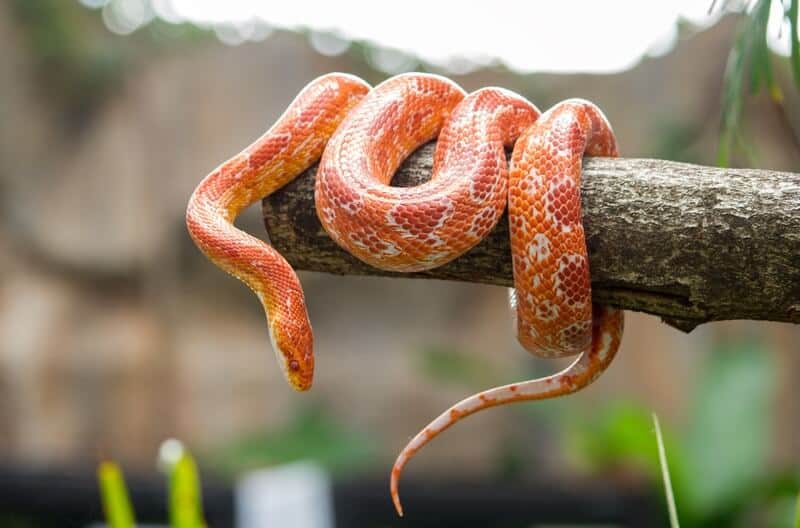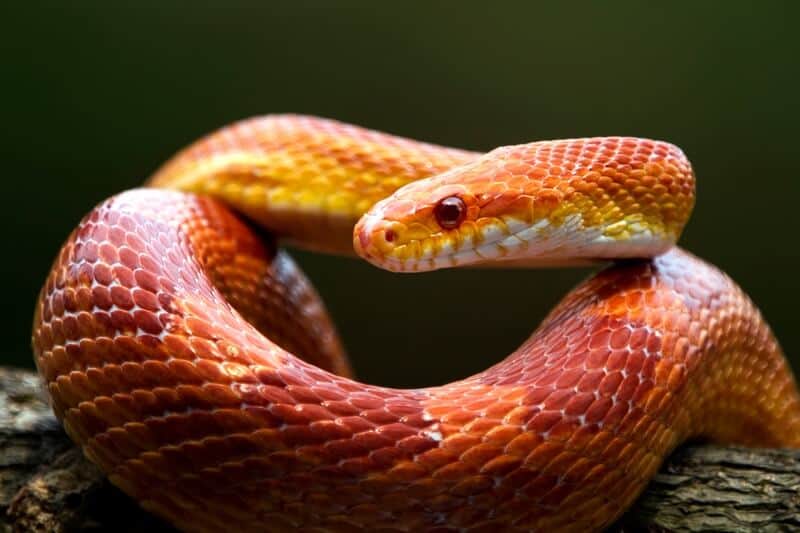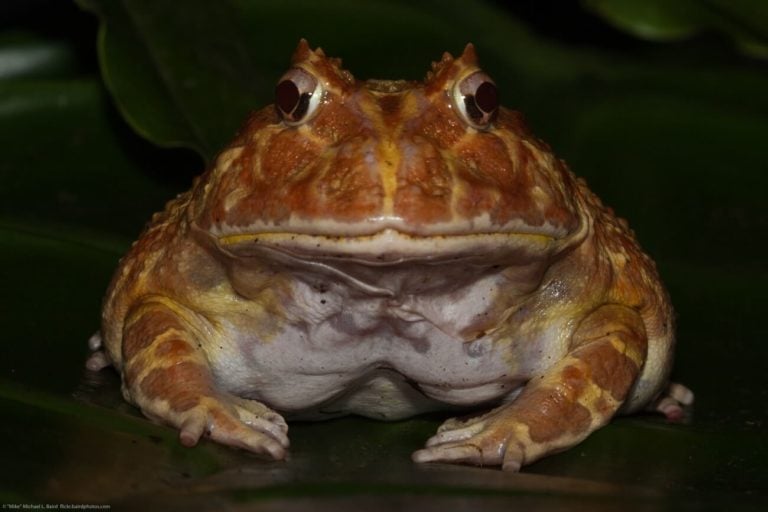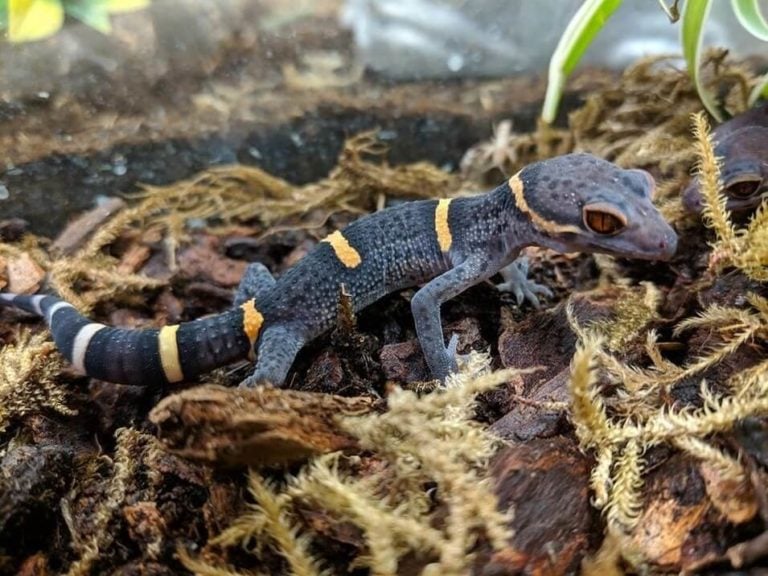Corn snakes are wonderful pets that have been popular among reptile-lovers for quite a while. Low-maintenance and fun to observe, we find ourselves recommending this species to others quite frequently!
This guide will go over the essentials of corn snake care. You’ll learn about their diet, enclosure setup, full size, lifespan, and more!
Table of Contents
Species Summary
Of all the available snake species in the pet trade, the corn snake (Pantherophis guttatus) is one of the most popular. When you think about what these reptiles have to offer, it’s not hard to see why.
Docile and undemanding, corn snake care is quite simple regardless of skill level. Novice herpetology lovers can hone their husbandry skills while enjoying the company of a peace-loving snake. Meanwhile, seasoned snake-keepers often collect the many vibrant morphs.
Corn snakes make lovely pets and are often the first introduction to snakes that many people have.
Average Corn Snake Size
When it comes to size, corn snakes are pretty manageable. They’re not intimidating due to their size, and they’re also easy to handle. Even kids can get in on the husbandry action thanks to their relatively small size.
However, they’re also sizable enough to impress. Plus, their girth and overall length ensure that these snakes aren’t too delicate for physical handling.
As the snake reaches adulthood, it will grow to several feet long. Most adult snakes will reach a length of four or five feet in length. On rare occasions, some corn snakes will grow to about six feet!
Expert Tip: After hatching, juvenile corn snakes are typically a foot long at most. On the smaller end of the spectrum, they can be as short as eight inches.
Appearance & Colors
One of the things that reptile enthusiasts love about corn snakes is the wide variety of color morphs available. This species is pretty easy to breed. As a result, breeders have run wild with morphs and varieties!

Selective breeding paved the way to over 800 distinct morphs! Each one has a unique skin pattern or color.
The “standard” color is what you’d encounter in the wild. They have a base color of light brown or gray. Splotches of eye-catching reddish-brown cover the body, creating an attractive natural pattern.
Other popular color morphs include albino and hypomelanistic. Albino corn snakes have hues of cream and pink. Meanwhile, the hypomelanistic varieties take on deep shades of pinkish-red.
You may also come across corn snakes with lavender, crimson, orange, and pure white coloration. There’s a lot of variety with this species, making it a favorite among reptile collectors.
Corn Snake Lifespan
The average corn snake lifespan is between 10 and 15 years. However, these reptiles are fully capable of living longer with the proper care.
There’s no way to guarantee or accurately predict an exact lifespan. Many factors contribute to the animal’s overall health. That said, the quality of corn snake care you provide does matter.
Corn snakes living in pristine living conditions can live beyond 20 years! However, those with substandard care can die prematurely due to disease.
Corn Snake Care
Corn snake care is incredibly straightforward, which is why they’re considered by most to be a very beginner-friendly species. They adapt well to life in captivity and are readily available at most pet stores. But like any other living creature, corn snakes have their preferences and ideal living conditions.
To keep your corn snake happy and healthy, stick to the following care guidelines.
Enclosure Size
The most important thing to put your money towards when it comes to corn snake care is its enclosure.
Thanks to the small size of this species, a massive tank size is unnecessary. Adults can live comfortably in a 20-gallon tank. If you’re buying a juvenile, you’ll only need a shoebox-sized tank of 10-gallons or so!
Expert Tip: As always, bigger is always better when it comes to enclosure size. Corn snakes will appreciate more space. Not only that, but a more extensive habitat can make things easier when maintaining environmental conditions.
Habitat Setup
Decorations aren’t a massive issue with corn snakes. Unlike other species, these reptiles don’t require a ton of flashy additions to their habitat. They do just fine with a basic setup.
Start with a substrate material. You have several options here, but the best is loose material like aspen shavings or coconut coir. Corn snakes like to burrow. While you could use something like newspapers or reptile carpet, most snakes will try to wriggle their way underneath it.
Loose substrate scratches that burrow itch while catching messes and maintaining humidity levels. Avoid using a substrate with ultra-fine pieces. For example, sand and soil mixes are generally a bad idea due to the risk of impaction.
Steer clear of scented wood mulches, too. The oils in them could cause your snake harm.
On top of the substrate, add some complete and partial-coverage decorations. Good examples here include tall artificial plants or caves.
Alternatively, you can stick to a couple of simple hide boxes. Two hide boxes are best so that your corn snake can find solace on both ends of the tank. Some owners like to create single long hides with a PVC pipe.
Expert Tip: Both options work well. The goal is to give your corn snake the chance to get shelter from the sun and cool off. Hides provide that opportunity without forcing you to modify temperature settings in the tank.
Temperature & Lighting
These reptiles can adapt to a broad range of temperatures, but there are certain conditions to keep in mind if you wish to provide the best corn snake care possible.
Generally, these snakes prefer ambient temperatures around 80 degrees. At night, things can cool off to about 75 degrees. Anything lower than that, and you’ll need to invest in a heat emitter to stabilize temperatures.
Corn snakes require a temperature gradient. Different temperature zones allow the snake to thermoregulate as it sees fit.
To establish the gradient, use a basking lamp. The difference in temperatures doesn’t have to be extreme. Corn snakes prefer a basking spot with about 85 to 88 degrees Fahrenheit.
Expert Tip: Don’t forget to keep the lamp out of the enclosure to prevent accidental burns.
Whether or not corn snakes require UV lamps is a point of contention among reptile enthusiasts. Some believe these lamps are an essential part of proper corn snake care, while others believe that natural light from your home is more than enough.
To be on the safe side, we think it’s a good idea to include UV lights in their habitat setup. A standard 5-percent T8 lamp will do. Position it to cover the entire enclosure with light. Thanks to those hides you installed earlier, your snake can choose to bask in the artificial sun or hide from it.
Corn snakes follow a typical day and night cycle. As a result, you need to connect both the standard and UV lamps to a timer. Around eight to 12 hours of light is ideal for this species.
Humidity
Your corn snake’s habitat should have humidity levels between 40 and 60 percent at all times. It’s important to install a hygrometer inside so that you’re able to monitor humidity around the clock.
To raise humidity levels, you can mist the enclosure a couple of times during the day. Many snake owners also like to use sphagnum moss. All you have to do is soak the moss in water and scatter it around the tank. It’ll slowly evaporate and raise the humidity levels without creating a mess.
Water
Corn snakes don’t necessarily drink water by lapping it up. They can absorb moisture from the air and through soaking.
But despite this, these snakes need a bowl of clean water in their habitat at all times. Use a shallow dish that’s large enough for the snake to get in for a soak.
Expert Tip: Replace the water at least once a week. If your corn snake excretes waste into the bowl, you may need to clean it and replenish the water more frequently.
Food & Diet
The best food for adult corn snakes is mice. You can provide live mice, but they may pose a safety risk. Active mice can fight back, creating injuries that ultimately lead to infection.
To avoid all that, many reptile enthusiasts provide pre frozen mice that are adequately thawed to room temperature.
Generally, adults will need to eat about once a week. Provide a single rodent that’s no bigger than 1.5 times the width of the girthiest part of your snake’s body.
Expert Tip: Mice are the go-to, but corn snakes will sometimes eat other foods as well. You can try providing lizards, frogs, freshly hatched birds, or eggs. Every snake’s preference for these foods is different, so you may need to experiment to determine what your snake likes.
Potential Health Issues
Corn snakes are susceptible to many of the same potential health issues as other popular species, and proper corn snake care requires you to be mindful of this.
Respiratory infections are a common issue that stems from improper temperature or humidity levels. Symptoms include open-mouth breathing and swelling of the tissue inside the mouth.
Mouth rot and fungal infections are prevalent as well. The former leads to inflammation and discharge. Meanwhile, fungal infections often cause skin discoloration.
Fortunately, these conditions are all treatable by a vet with experience in herpetology. Many health problems are avoidable as well with regular enclosure maintenance.
Spot clean messes as they occur and do a deep clean about once a month. During the thorough cleaning, sanitize every surface to keep bacteria and pathogens under control.
Behavior & Temperament
For the most part, corn snakes are easy-going. They are notoriously shy and can be defensive in near environments. However, that behavior tends to go away as the snake gets more comfortable in its new home.
After that, they’re pretty docile and easy to manage. You’ll only encounter issues if you attempt to keep more than one corn snake together. Corn snakes aren’t social and should be kept alone at all times.
Throughout the day, these snakes will lounge around and move about to regulate their temperature. You may see them out in the open or hiding in one of the shady spots you provide.
Expert Tip: This species is prone to escape attempts, so don’t be surprised if you see your snake trying to wriggle its way out. Make sure to outfit your enclosure with a tight lid, and you shouldn’t have any issues keeping the corn snake contained.
Handling
It takes some time for corn snakes to get comfortable with handling. At first, they’re far too nervous. Most will flee and hide the second you stick your hand in the enclosure.
After getting comfortable for several weeks, you can attempt to handle the snake for short periods. Work your way up, and the snake will realize that you’re no threat. Once it reaches that point, corn snakes become tame enough to handle frequently.
If they do exhibit signs of aggression, give the corn snake its space. While they might attempt to bite, corn snakes aren’t capable of causing any actual harm or injury. That said, it’s still a good idea to provide space and not force handling whenever your snake isn’t feeling up to it.
Closing Thoughts
We hope this guide on corn snake care has given you the tools you need to help your pet reptile thrive. This is one of our favorite species, so it’s always fun to share our knowledge and discuss these animals with our readers.
If you have any questions that weren’t addressed in the guide above, feel free to send them our way. We’ll respond as soon as possible!



